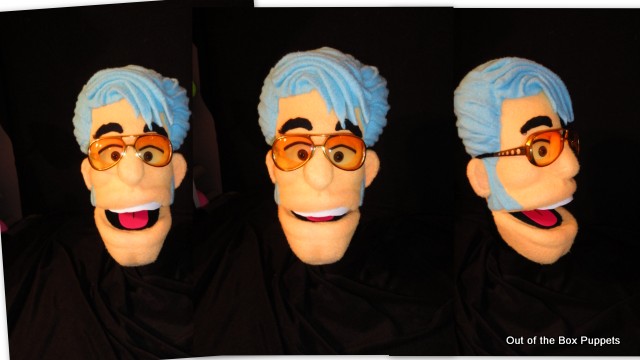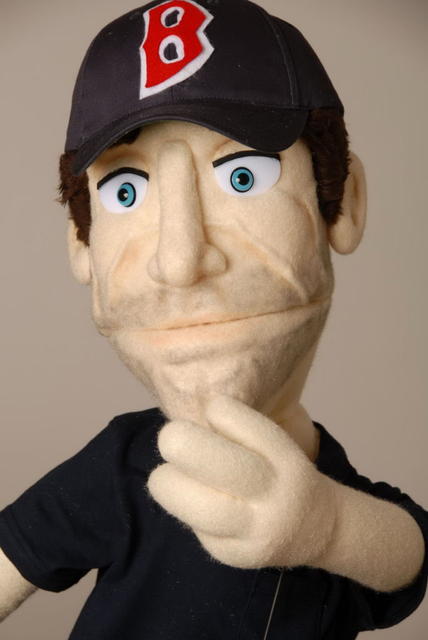foam density for painting Posted by Michael_M on Jun 09, 2014
This may not be a question that is easily answered...
I purchased 1/2" polyfoam from the local fabric store. Although I like the appearance of a fleece puppet, I want to try painting my puppet to make use of my airbrush and to save time and expense. When I did a paint test using a brush and acrylic paint the pores become very visible. Then I tried to seal it with diluted Weldbond first but that didn't make much of a difference. I know that foam comes in different densities. Am I correct in assuming this would make a difference? Problem is the fabric store only has one option.
Furry Puppet does such great work. I know some of their puppets are fleece but I get the impression that some are painted. For example this guy:

The fullscreen image is here: http://www.furrypuppet.com/blog/wp-content/uploads/2014/04/custom-puppet-full-resolution.jpg
Maybe I'm just being too picky. But if there's a better option out there I would want to pursue it. Thanks for any feedback.
I purchased 1/2" polyfoam from the local fabric store. Although I like the appearance of a fleece puppet, I want to try painting my puppet to make use of my airbrush and to save time and expense. When I did a paint test using a brush and acrylic paint the pores become very visible. Then I tried to seal it with diluted Weldbond first but that didn't make much of a difference. I know that foam comes in different densities. Am I correct in assuming this would make a difference? Problem is the fabric store only has one option.
Furry Puppet does such great work. I know some of their puppets are fleece but I get the impression that some are painted. For example this guy:

The fullscreen image is here: http://www.furrypuppet.com/blog/wp-content/uploads/2014/04/custom-puppet-full-resolution.jpg
Maybe I'm just being too picky. But if there's a better option out there I would want to pursue it. Thanks for any feedback.
Re: foam density for painting Posted by Angel in Tx on Jun 09, 2014
I died foam once for a puppet with RIT dye, but it faded much more quickly than the fleece covered one. Foams do come in different densities, but I have yet to figure them all out! I think that the muppets that are made with out fleece covering are made with something called Scott foam, but the pores do show. The puppet you show in the picture looks like painted/airbrushed fleece. Some of http://www.pavlovspuppets.com/ are like this too. They are gorgeous!
Re: foam density for painting Posted by Out of the Box Puppets on Jun 10, 2014
Yes, I agree with Angel. The Furry puppet is antron airbrushed and or pastels.
Julie
Julie
Re: foam density for painting Posted by jeezbo on Jun 11, 2014
The old sailor from furry puppet that you have put up is simple polar fleece believe it or not (yes, I was surprised too!!) and the colour details are merely dry pastels gently applied to the shaven fleece.
I am quite friendly with Zack at furry puppets and this is exactly what he said when I asked him about this particular puppet (he told me because this is what I make some of my puppets from and I also use dry pastels to give detail, I was just so impressed at the beauty of their work that I didn't realise) it is also a great example of what forethought and planning can do as the puppet looks like its made from a fancy material, but its made from polar fleece with the seams cleverly placed and hidden (the seams are in places you would not have though of putting them!) the same colour detail can be achieved on foam as well (as Julie has already said) but you would need to seal it well to prevent the colour from coming off too much, however its quite well known that dry pastels kind of stain the surface, so the colour will stay on fairly well even if you don't seal it with something like hair spray or a very light layer of acrylic lacquer (yes, you read that right, a VERY LIGHT layer will protect but stay as flexible as the foam itself) or you could always try floral display paint like our friend Angela Beasley at puppetpeople.com.
I am quite friendly with Zack at furry puppets and this is exactly what he said when I asked him about this particular puppet (he told me because this is what I make some of my puppets from and I also use dry pastels to give detail, I was just so impressed at the beauty of their work that I didn't realise) it is also a great example of what forethought and planning can do as the puppet looks like its made from a fancy material, but its made from polar fleece with the seams cleverly placed and hidden (the seams are in places you would not have though of putting them!) the same colour detail can be achieved on foam as well (as Julie has already said) but you would need to seal it well to prevent the colour from coming off too much, however its quite well known that dry pastels kind of stain the surface, so the colour will stay on fairly well even if you don't seal it with something like hair spray or a very light layer of acrylic lacquer (yes, you read that right, a VERY LIGHT layer will protect but stay as flexible as the foam itself) or you could always try floral display paint like our friend Angela Beasley at puppetpeople.com.
Re: foam density for painting Posted by Krafty Karacters on Jun 11, 2014
I love this effect of pastels on fleece, i am totally inspired to try it. Would you need to seal it on fleece as it was explained for foam? The puppets on furrypuppets website are just beautiful.
Re: foam density for painting Posted by Out of the Box Puppets on Jun 11, 2014
I use hairspray on the pastels depending on how dark I have applied them. If I just lightly shade i don't, but the mire you use the mire likely it will transfer to a light piece of fabric such as a hand if it touches that area.
I've never made a puppet not covered with fleece. The ones I have seen that were painted foam deteriorated faster.
Julie
I've never made a puppet not covered with fleece. The ones I have seen that were painted foam deteriorated faster.
Julie
Re: foam density for painting Posted by Shawn on Jun 11, 2014
I really don't think you are going to get rid of the pores showing on foam when you paint it. Yes there is Scott or reticulated foam that many puppeteers like to use but it actually has a more open pore and thus would show more then the foam you are using. The Muppets along with other puppeteers use flocking to cover the raw foam. This gives you a smoother "skin" much like covering with fleece.
Re: foam density for painting Posted by Michael_M on Jun 11, 2014
Posted by: jeezbo on Jun 11, 2014
I am quite friendly with Zack at furry puppets and this is exactly what he said when I asked him about this particular puppet (he told me because this is what I make some of my puppets from and I also use dry pastels to give detail, I was just so impressed at the beauty of their work that I didn't realise)
When I determined I needed a puppet for a project I did research and Furry Puppet was the most impressive. I contacted them and Zack kindly replied but, sadly, I can't afford the high quality puppets they produce. I keep revisiting their site looking at examples and wishing I was that good.
A real surprise to learn the sailor is polar fleece. I wish they would produce a training video although I don't think I have the patience for foam carving. Don't know how they are able to maintain symmetry. I find clay sculpting difficult. The fact that all their puppets are original designs rather than using a commercially available patterns really makes a difference.
The Muppets along with other puppeteers use flocking to cover the raw foam. This gives you a smoother "skin" much like covering with fleece.
I attempted this on some foam but it didn't work out. No doubt I did something wrong or they have better quality flocking.
Re: foam density for painting Posted by Out of the Box Puppets on Jun 12, 2014
I have never sculpted foam before, but I think you can achieve good results with piecing things together. This is an example. I used part of the Punto pattern for the top half of the head, created a pattern for the lower jaw and added features on top. This photo is before i trimmed down the features or added noses. The other covered puppets all came from this same base. Only some had foam lips added, different shaped cheeks etc.






Hope this helps.
Julie



Hope this helps.
Julie
Re: foam density for painting Posted by Out of the Box Puppets on Jun 13, 2014
Thanks Shawn for fixing the photos. Behind the scenes awesome.
Julie
Julie
Loading
No More Post
Error
Loading